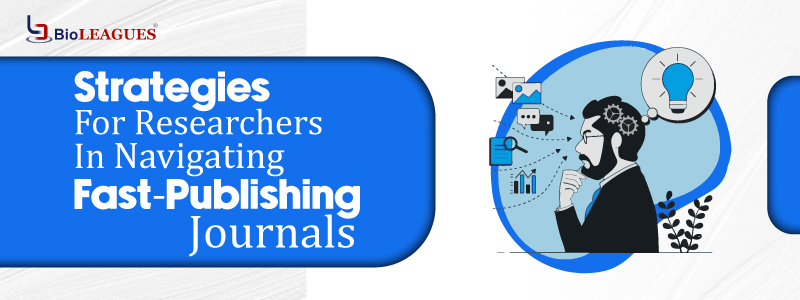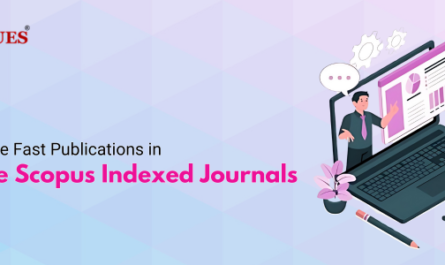Understanding The Importance Of Fast-Publishing Journals
The significance of publishing research findings cannot be understated in the academic and scientific communities. It allows scholars to share their discoveries with their peers, fostering dialogue, criticism, and further study. However, traditional Scopus journal publication channels can be time-consuming and often delay the dissemination of these important findings. As a remedy, fast-publishing journals have emerged as a crucial component in the academic landscape. These journals, particularly those indexed in reputable databases like Scopus, present a host of advantages for researchers.
The Need For Timely Publication In Research
- In the rapidly evolving world of academia and research, time is of the essence.
- Researchers are under constant pressure to publish their research discoveries swiftly, primarily due to three reasons: academic credit, intellectual property rights, and societal impact.
- Firstly, researchers aim to publish their results quickly to secure academic credit. Scopus journals and publications are a key metric for academic progression, securing funding, or even attaining tenured positions.
- Therefore, the faster their research is published, the quicker they can gain recognition.
- Secondly, in an environment characterized by intense competition, securing intellectual property rights is crucial.
- Fast Scopus journal publication 2025 can help researchers establish their work’s precedence, thereby guarding against potential intellectual property disputes.
- Lastly, timely publication is essential for societal impact. Hence, fast track publication journals help in this regard more aptly
- In fields like medicine, environmental science, or technology, rapid dissemination of research can significantly benefit society by providing prompt solutions or advancements. Thus, fast publishing scopus journals are crucial in this case
Fast-Publishing Scopus Journals – A Preferred Choice
- Fast-publishing journals indexed in Scopus offer researchers a quicker pathway to share their findings without compromising the quality of peer review or the journal’s recognition.
- Here’s why they have become a popular choice –
- Credibility & VisibilityScopus is the largest abstract and citation database of peer research, and it adds a level of credibility to the research and enhances its visibility among the global academic community.
- Accelerated Publication ProcessThese journals typically have streamlined review, and Scopus indexed journals 2025 fast publication processes. By reducing unnecessary delays, they ensure that research findings reach the public domain promptly.
- Quality AssuranceDespite the quick turnaround times, fast-publishing Scopus journals maintain rigorous peer-review processes. This ensures that the quality of research is not compromised, thus maintaining the integrity of the published work.
- Greater ImpactOwing to their global reach and accessibility, research published in fast-publishing Scopus journals tends to have a greater impact. This is measured using metrics like citations, which are readily available through the Scopus database.
Strategies For Researchers In Navigating Fast-Publishing Journals

- Selecting the right fast-publishing journal for research requires a strategic approach. Here are some tips for researchers –
- Understanding Journal ScopeIt is crucial to understand a journal’s scope to ensure alignment with the research topic. Misalignment can lead to outright rejection, thereby wasting precious time.
- Checking Indexing & Impact FactorWhile the urge to publish quickly might be high, it is critical to verify the journal’s indexing and impact factor. Publishing in well-indexed journals with a good impact factor ensures wider recognition and impact.
- Reviewing The Journal’s Editorial BoardThe credibility of the journal’s editorial board is a good indicator of its quality. Board members associated with reputable institutions add credibility to the journal.
- Reading Past Published ArticlesReviewing previously published articles can provide insight into the journal’s quality and the kind of research they prefer.
Fast-publishing journals, especially those indexed in databases like Scopus, serve as a viable and efficient avenue for researchers to disseminate their work. They address the need for speed in today’s academic world without compromising on quality or visibility. However, as with any publication venture, it is crucial for researchers to conduct thorough due diligence and make informed decisions to maximize their research’s reach and impact.
- Factors Influencing Publication Speed
- The process of getting academic research published is a journey that can often be influenced by a variety of factors.
- The speed at which a manuscript travels from submission to publication in a journal can be crucial for researchers, particularly in fields where findings may be time-sensitive.
- In this regard, understanding the factors that influence publication speed can help researchers strategize their submissions more effectively.
- Attend a call for papers in Scopus indexed journals 2025 today to have your research published quickly.
- Editorial Processes & Their Influence On Publication SpeedThe editorial process is the first gate that a manuscript must pass through, and it has a significant influence on publication speed.Several aspects come into play –
- Initial ScreeningAfter submission, the manuscript undergoes an initial screening to check its suitability for the journal in terms of scope, format, and basic quality standards. The efficiency and responsiveness of the editorial staff play a vital role in this phase.
- Editorial Decision MakingEditors play a pivotal role in the process. They decide whether the manuscript should proceed to peer review or be rejected outright. Their expertise and ability to manage multiple submissions simultaneously can significantly influence the turnaround time.
- Peer Review Timelines & Their Impact On Publication SpeedPeer review is a crucial element of scholarly publishing, offering a method for validating the quality and reliability of academic research.However, it can be a time-consuming process –
- Reviewer Selection & AvailabilityFinding appropriate reviewers who are also available to conduct the review promptly can be challenging.Editors often need to balance between waiting for top experts, who may be busy, and opting for less renowned but available reviewers.
- Review ProcessThe time reviewers take to assess the manuscript can vary based on their workload, interest in the topic, and their meticulousness. Some journals utilize a ‘fast-track’ review process for certain articles, where reviewers are asked to provide feedback within a shorter timeframe.
- Production Efficiency As A Determinant Of Publication SpeedAfter clearing the peer review hurdle, the manuscript enters the production phase. Several aspects can impact the efficiency of this stage –
- Manuscript Type-SettingThis involves converting the manuscript into the journal’s specific layout and format. Efficient coordination between the author and the production team can significantly reduce delays.
- Proofreading & CorrectionsProofreading for typographical errors, language inconsistencies, and layout issues is vital. Quick and accurate corrections by authors can help speed up this stage.
- Online PublicationMost journals now offer online publication before the print version. This allows the research to be accessible sooner, enhancing the dissemination speed.
- The speed of journal publication is influenced by a range of factors, from editorial efficiency to peer review timelines and production efficiency.
- Understanding these can help researchers make informed decisions about where to submit their manuscripts.
- By being aware of these processes and proactively managing their submissions, researchers can influence their publication speed to ensure their research is disseminated in a timely and effective manner.
- Reviewing Journal Metrics & Reputation
- Navigating the world of academic publishing is not merely about managing the timeline from manuscript submission to publication.
- The journal’s reputation and its metrics also hold significant value. They influence not only the perceived value of your work but also its visibility among peers.
- Therefore, researchers must understand these elements and how they intertwine with publication speed.
- The Relevance Of Journal Metrics In Determining Publication SpeedJournal metrics are quantitative measures used to evaluate or compare scholarly journals. They offer a quantifiable benchmark of the journal’s impact and quality. The most common metrics are the impact factor and citation index.
- Impact Factor
- Published annually by Clarivate Analytics, a journal’s impact factor measures the average number of citations that articles published in the previous two years have received in the current year.
- While it doesn’t directly influence publication speed, higher-impact journals often receive more submissions, leading to a more competitive selection process and potentially longer review times.
- Published annually by Clarivate Analytics, a journal’s impact factor measures the average number of citations that articles published in the previous two years have received in the current year.
- Citation IndexCitation indices, like those found in Scopus or Google Scholar, track the citations that articles receive across many journals and platforms. A higher citation index can indicate a higher quality of published articles. Like impact factors, high citation indices can increase competition and potentially slow down publication speed.
The Role Of Journal Reputation In The Academic Community

- Journal reputation is more subjective than quantifiable metrics but no less critical.
- A journal’s standing in the academic community can affect the perception and visibility of your work.
- Subject-Matter Relevance
- If the journal is recognized for publishing ground-breaking work in your field, it increases the likelihood of your research being seen and cited by your peers.
- These journals can be very selective and may have longer review and publication timelines due to the high volume of submissions.
- If the journal is recognized for publishing ground-breaking work in your field, it increases the likelihood of your research being seen and cited by your peers.
- Endorsement By Professional BodiesJournals endorsed by renowned academic or professional bodies often carry a mark of quality and trust. Researchers should note that these journals often have stringent peer review processes, which might extend the publication timeline.
- Perceived QualityA journal’s reputation is often tied to the perceived quality of its articles. Journals known for rigorous review processes and high-quality articles tend to have a good reputation but may also have longer publication times.
- While fast publication can be a crucial factor for researchers, it’s also essential to consider the journal’s metrics and reputation.
- The impact factor, citation index, and the journal’s standing within the academic community can impact not only how your research is perceived but also the publication speed.
- Thus, a holistic view of these elements can help researchers make well-informed decisions about where to submit their work, balancing the need for speed with the recognition and reach their research deserves.




